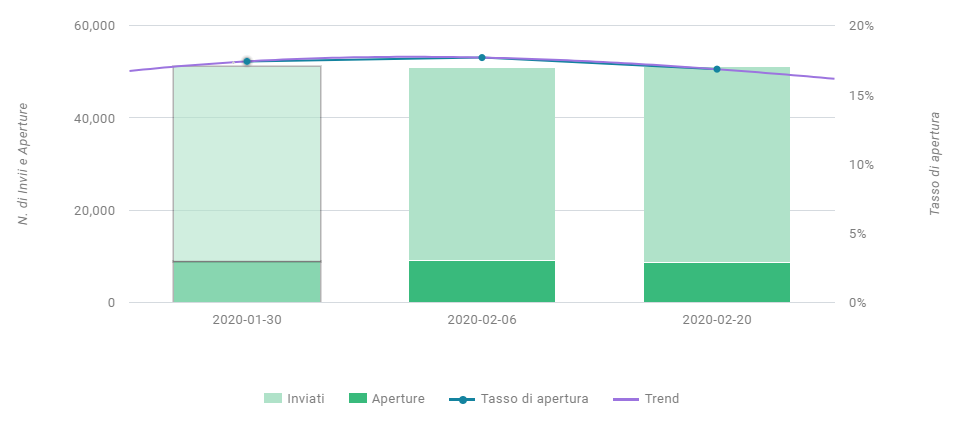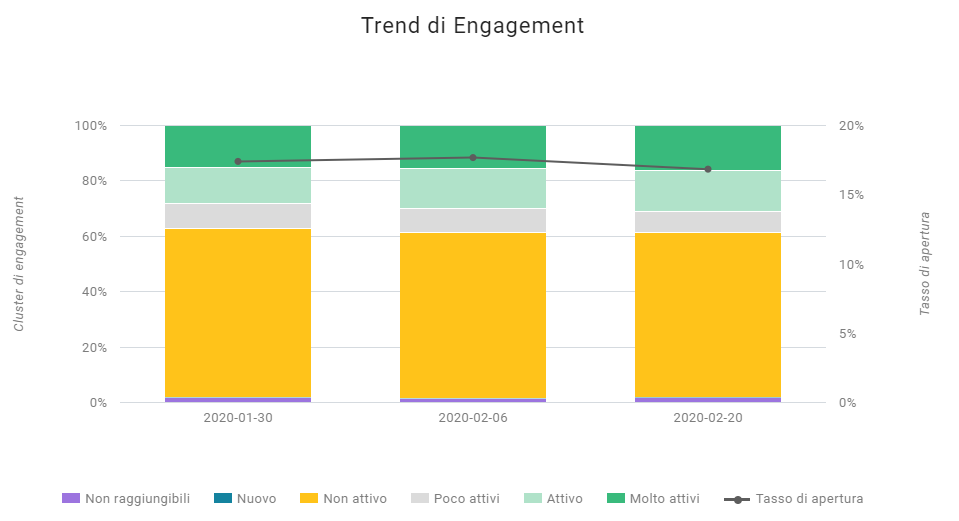How to Measure Engagement in Email Marketing

We are aware that sales hinge on appreciation, trust, and a strong brand-consumer relationship, nothing new there. What’s more challenging is having a full understanding of how to cultivate and monitor this relationship.
Increasingly reliance is placed on the term ‘engagement,’ which encompasses many discussions regarding a company’s ability to establish – through communication – a solid, deep, and lasting relationship with the customer/user.
Today, we want to focus precisely on engagement, applying it to Email Marketing, to demonstrate how it’s a parameter far from abstract, but tangible, analyzable from within, and therefore, improvable.

From developing integrations to strategic support, from creating creative concepts to optimizing results.
What is Engagement in Email Marketing?
Engagement measures the success of an email message shared with its recipients.
In simpler terms, we can say that engagement provides companies with the measure and degree to which people interact with a single email or a set of emails, answering questions about how recipients:
- Open the message
- Read the content
- Click on links and calls to action
- Unsubscribe or report messages as spam.
Why Measuring Engagement is Important?
The funnel representation of engagement tells us that individual metrics are not separate, stagnant compartments, but rather interdependent and connected planes, where each measurement depends on the previous one and influences the next. To put it simply, the trend of clicks depends on openings, just as openings depend on the delivery rate.
This is why engagement is so important: its metrics allow companies to inform subsequent campaigns, provide crucial insights into where to intervene to improve, and trigger a positive cascading effect.
Let’s now see how to measure engagement, observing it from two angles: that of the individual email campaign and that of the entire strategy.
Measuring Engagement at the Campaign Level
Openings
One of the first metrics observed is the number of people who have opened the email. You can consult the total number of openings (Open Rate) or the number of unique openings (Unique Open Rate): between the two, the most reliable data is the latter, since – not counting repeated openings by a recipient – it offers a better understanding of the number of recipients who chose to open the email based on the sender, subject, and preheader.
Clicks
From openings, we move on to clicks, the metric that indicates the relevance of a message once opened. As with openings, it is advisable to prioritize the measurement of unique clicks (Click-through Open Rate) rather than total clicks (Click Rate), in order to have a better understanding of each recipient’s responsiveness to the email content.
In the context of engagement, a good click-through rate (CTR) signifies that the involvement generated in the inbox (and certified by the opening) has also been confirmed once the email is opened. The click, in essence, capitalizes on, and finalizes the interest demonstrated by opening the email.
In addition to click-tracking tools, a useful feature is the so-called heat map, which provides a quantitative look at how clicks are distributed on a page or in an email. They provide the company with what we could call the ‘click geography.
Unsubscribes and Spam Reports
Also to be considered in engagement are the so-called negative metrics, such as the unsubscribe rate and spam reports. These are two parameters that indicate how many recipients reject communications, opting for removal from the database or more drastic action like reporting to the provider.
A high level of these negative metrics should necessarily prompt the company to reconsider its campaigns at all levels: from the subject line to the content conveyed, through to sending frequencies. In this context, segmentation and personalization activities represent the best ways to increase the relevance of messages and keep unsubscribes and spam reports under control.
A Fundamental Metric for Engagement: Deliverability
The funnel we discussed earlier relies on a metric that doesn’t measure engagement but deeply influences it.
We’re talking about deliverability, which is the ability of emails to reach the recipients’ inbox. Deliverability depends, especially at the outset, on the quality of the sending infrastructure. It’s a complex yet crucial topic for the success of a strategy.
Measuring Engagement at the Strategy Level
A more challenging task is measuring engagement at the strategy level, in order to understand the overall performance of campaigns over a broader period of time. You can conduct an analysis of your own sends or rely on Engagement Statistics, the feature of MailUp that provides advanced statistics on campaign performance and recipient engagement.
Specifically, Engagement Statistics allows you to visualize in detail:
Trend of Openings
- Number of openings recorded each day and number of sends
- Opening rate
- Change in trend compared to the opening rate over the selected time frame.

Trend of Clicks
- Number of clicks recorded each day and number of sends
- Click-through rate
- Change in trend compared to the click-through rate over the selected time frame.

Trend of Providers
Provides an overview of the four main providers of recipients.

Engagement Trend
Provides an overview of the health status of the database. For each day on which at least one send was made, the graph divides recipients into:
- Active. The recipient has demonstrated a medium level of engagement, being a contact that often takes actions on the campaigns received.
- Less Active. The recipient has shown low engagement or the user is new and has not yet been able to take any actions.
- Very Active. The recipient has demonstrated a high level of engagement, being a contact that consistently engages with campaigns.
- Inactive. The recipient does not interact with messages.
- Error. The recipient has recorded a high number of bounces and soft bounces.
- New. Recipients for whom no rating information is yet available, as no sends have been made yet.

How to Guide New Campaigns Based on Engagement
In addition to and complementing Engagement Statistics, MailUp provides a new set of filters that allows you to use the information gathered in Engagement reports to create recipient segments based on a series of conditions:
- Very Active Recipients
- Active Recipients
- Less Active Recipients
- Inactive Recipients
- New Recipients
- Unreachable Recipients
Thanks to the Engagement filters, it is possible to create tailored campaigns calibrated to the level of engagement. You just need to choose the filter, and the MailUp platform takes care of providing you with the recipient cluster.
In conclusion
Engagement represents the most valuable parameter for improving your campaigns because it can look at metrics as a set of interconnected elements, where optimizing each one is closely linked to the others.
To adopt this perspective, the advice is to start using MailUp’s tracking tools and functions today: you can request your free 15-day trial and start creating and sending your campaigns right away, then measure the level of engagement with customers and prospects.

From developing integrations to strategic support, from creating creative concepts to optimizing results.